As a catch-all term, streetwear is up there with the king of all 90s buzzwords, alternative, which was making its first mainstream inroads, coincidentally enough, around the time XLarge was founded.
It’s difficult for people who have grown up with the internet offering instant access to everything, but youth subcultures used to be an exclusive and often fractious world. By fractious, we mean that you could catch a very real beating for something as stupid as having the wrong hairstyle in front of the wrong group of people.
We’ve discussed XLarge and their trailblazing impact in terms of actually defining the aesthetic of streetwear. Lacking a wider concept, this kind of historical fact can become almost meaningless, rote learning. So let’s start at the beginning.
Punk, and its second generation American offshoot, hardcore is something generally acknowledged to be critically important in driving youth culture into modernity. Even people who still clearly can’t stand the music or its fans have to, however grudgingly, recognize this historical debt. Back when this stuff was originally happening, in the late 70s and early 80s, this was absolutely, emphatically not the case.
It cannot be overstated how outside of mainstream thought, let alone acceptance, that this music and fashion actually was. Of course the usual roll call of parents, teachers, cops, and other busybodies hated it, but the animosity was just as strong with other kids. You wouldn’t think that heavy metal and punk were irreconcilable, but for years got along as well as rival English football supporters.
Things started to thaw as the music naturally evolved. As 80s hardcore hit a wall, it incorporated formerly verboten elements like heavy metal and classic rock. This progression involved the slowed down incarnation of Black Flag, the guitar heroics and heavy distortion of Dinosaur Jr., the avant-garde noise/loud electric guitar mix of Sonic Youth, and the straight up blend of punk and classic hard rock of Mudhoney, just to name a very few.
When Nirvana became certified, number one, hit makers, over a decade’s worth of underground culture was suddenly the toast of mainstream U.S.A. Having spent years reviling then ignoring this movement, most media outlets weren’t in a position to accurately fill in these new fans. “Alternative” just seemed to fit this blend of influences.
To complicate things further, this time period also saw hip-hop grow from something that took place on literal street corners into a new, massive pop music movement. There were growing pains, Joe Strummer famously laid into a shocked Clash crowd at New York’s Bond’s Casino when they booed Afrika Bambaataa before he had uttered a sound, but the blend of catchy music and brash, anti-establishment nature of seminal artists like N.W.A., Public Enemy, Ice-T, and the Beastie Boys, among others, made hip-hop an integral part of youth culture.
What makes a truly excellent streetwear piece is that two people can take two entirely different approaches to it, and it would work out for both of them, thus giving them one more thing in common than they had to start. You could even say that this nexus is the foundation of streetwear, and it’s what XLarge helped build.








Photography: Ricky Orng + Mikey Janney
Words: Dan Alvarez






